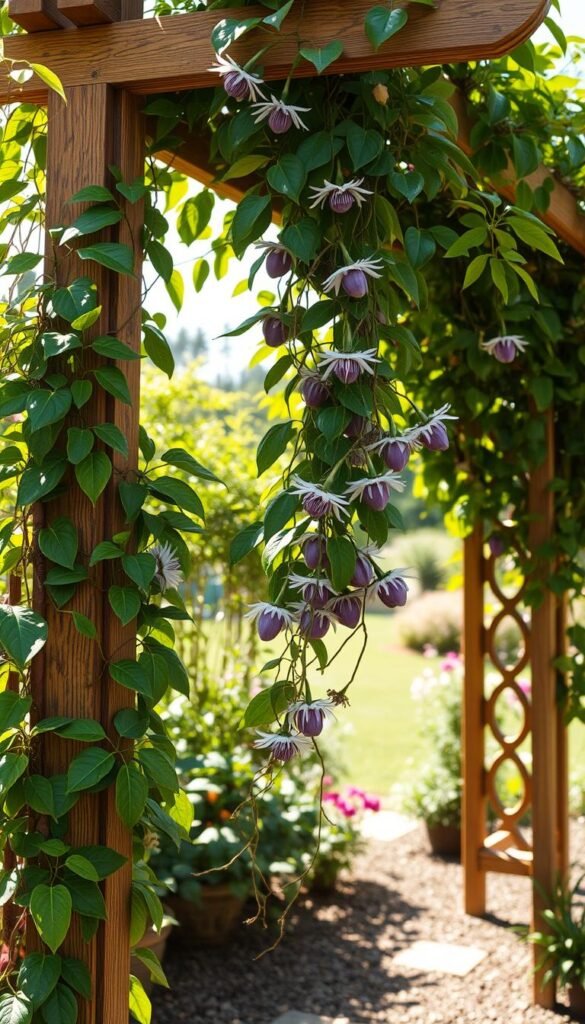Imagine transforming your outdoor space into a tropical oasis bursting with fragrant blooms and jewel-toned treats. These fast-growing vines naturally seek vertical surfaces, making them ideal for creative space-saving solutions in modern yards. With proper support, they’ll reward you with cascading greenery and abundant harvests within their first year.
What makes these vigorous growers stand out? Their twining tendrils grasp structures effortlessly, creating living curtains of foliage. You’ll witness rapid development – some varieties stretch 15-20 feet annually. This growth spurt demands sturdy frameworks that balance airflow with easy access to ripening treasures.
Smart vertical designs do more than save ground space. They prevent disease by keeping leaves dry and fruits elevated. The right structure becomes a living sculpture, showcasing intricate flowers that resemble alien spacecraft before maturing into sweet, tangy orbs.
Your garden gains multiple benefits from strategic planning. Well-designed supports simplify pruning and pest checks while maximizing sun exposure. Whether training along fences or crafting custom arbors, you’re building an edible landscape feature that evolves beautifully through seasons.
Getting Started with Your Passionfruit Trellis Garden
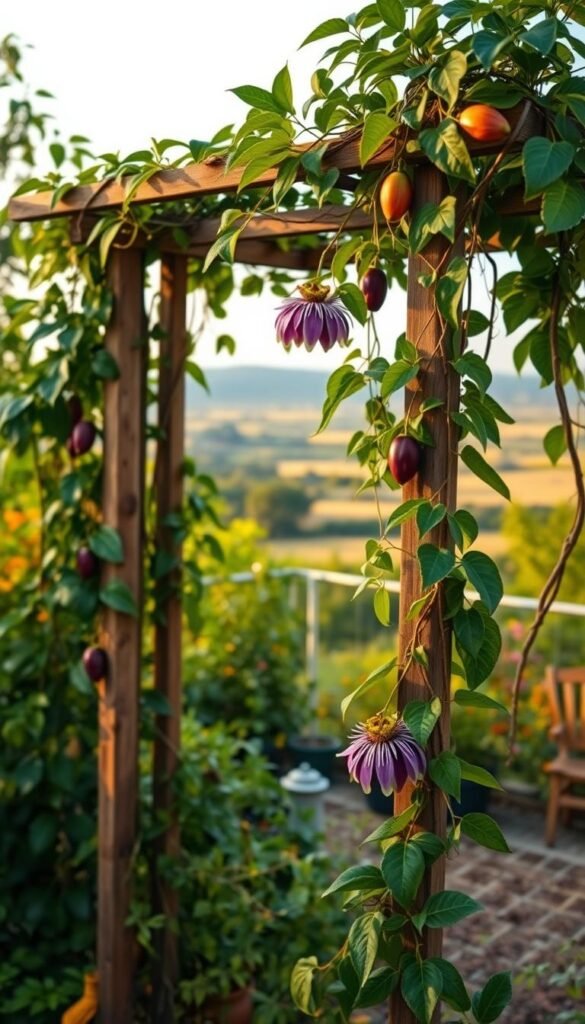
To grow passionfruit successfully, understanding their climbing nature is key. These vigorous growers use delicate tendrils to latch onto supports, creating living walls of foliage and fruit. Start by evaluating your yard’s microclimate—they crave sunshine like beachgoers crave sunscreen.
Understanding the Basics of Climbing Vines
Passionfruit vines don’t just climb—they hug their supports. Their spring-like tendrils tighten around structures within days. Choose materials that won’t damage these natural grips: rough wood or textured metals work best. Avoid smooth surfaces that could cause slips.
Setting Up Your Garden Space
Pick a south-facing spot that gets 6+ hours of direct sun. Test your soil’s pH—aim for 6.5-7.5. Mix in compost until the earth crumbles like coffee cake. Leave 10-12 feet between plants if using vertical gardening solutions for multiple vines.
Wind protection matters more than you’d think. A sturdy trellis acts as both support and windbreak. Position structures where you can easily reach both sides—future you will thank present you during harvest season.
Overview of Passionfruit Varieties and Their Growth Habits
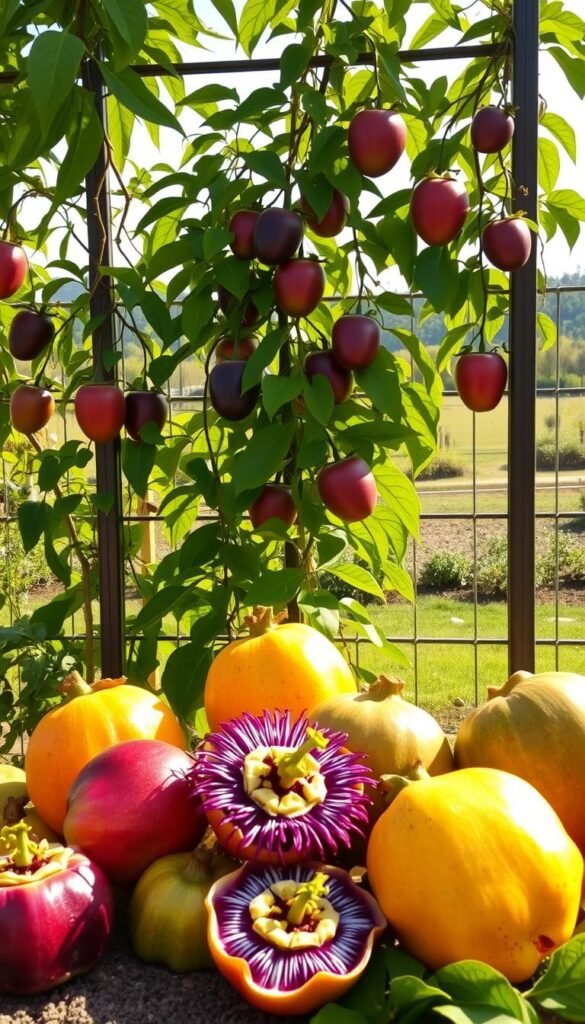
Selecting the perfect passionfruit variety feels like matchmaking for your garden. These sun-loving climbers come in distinct personalities, each thriving under specific conditions. Let’s explore what makes each type unique and how to pair them with your local weather patterns.
Key Differences Between Purple and Tropical Varieties
The classic purple type (Passiflora edulis) wins hearts with its honey-like sweetness and cold resilience. Native to Brazil’s highlands, it handles light frosts better than its tropical cousin. Fruits stay smaller (2-3 inches) but pack intense flavor perfect for fresh eating.
Golden tropical varieties (Passiflora edulis f. flavicarpa) bring bold tartness to juices and desserts. Their larger fruits (3-5 inches) thrive in steamy climates without winter chills. These heavy producers need consistent warmth – think Florida Keys weather rather than Carolina mountain air.
| Characteristic | Purple | Tropical |
|---|---|---|
| Flavor Profile | Sweet, floral | Tangy, citrusy |
| Fruit Size | 2-3 inches | 3-5 inches |
| Ideal Climate | Zones 9-11 | Zones 10-12 |
Identifying the Best Variety for Your Climate
Check your USDA zone before choosing. Purple types handle brief dips to 32°F, while tropical varieties sulk below 50°F. Hybrids like ‘Frederick’ or ‘Panama Gold’ offer middle-ground solutions for growing passionfruit in transitional zones.
Consider rainfall patterns too. Tropical varieties crave humidity, while purple types prefer moderate moisture. Urban gardeners in dry climates often succeed with container-grown purple plants using drip irrigation.
Designing a Trellis for Optimal Climbing and Support
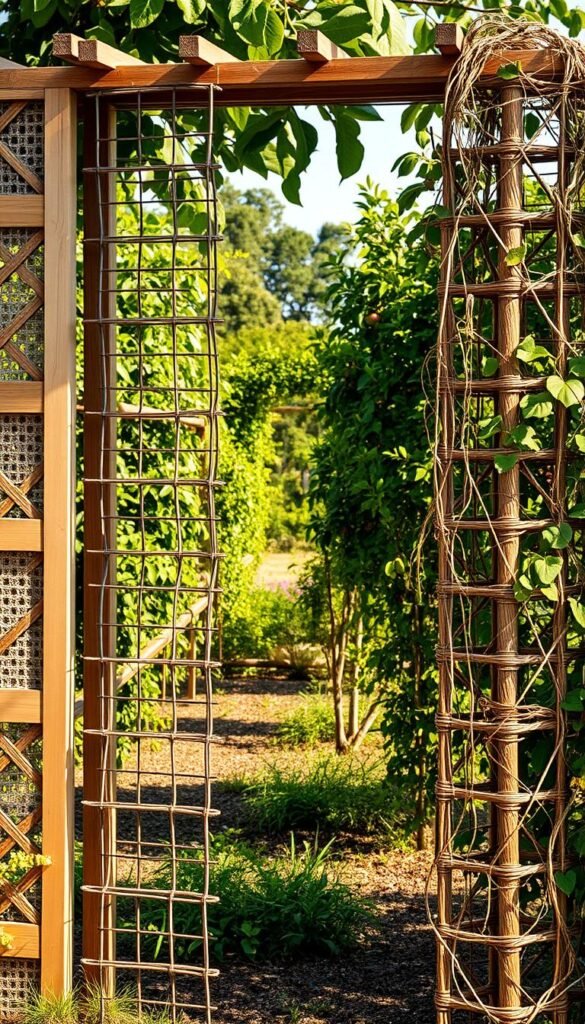
Your vine’s future home needs to be both functional and eye-catching. The right framework becomes a permanent partner in your plant’s journey, bearing weight while enhancing your outdoor space. Let’s explore how material choices impact durability and style.
Choosing Between Wooden, Metal, or Composite Designs
Wooden structures blend seamlessly with nature but demand yearly attention. Cedar and redwood resist rot better than pine. Expect to reseal joints annually and replace crossbars every 3-5 years in humid areas.
Galvanized steel options laugh at weather challenges. Their rigid frames handle mature vines effortlessly. Add rubber buffers where metal meets tender shoots to prevent heat damage. Coastal gardeners should opt for powder-coated versions.
Composite materials marry wood’s charm with plastic’s toughness. These low-maintenance choices won’t warp or splinter. While pricier initially, they outlast traditional options by decades. Perfect for busy growers wanting “set it and forget it” solutions.
Space horizontal supports 12-18 inches apart for optimal grip. Bury posts 2 feet deep in concrete for wind resistance. Remember: Your structure must withstand both leafy weight and seasonal storms. A wobbly base invites disaster when fruits swell in late summer.
Passion Fruit Plant Trellis Garden Ideas: Climbing Solutions for Lush Growth
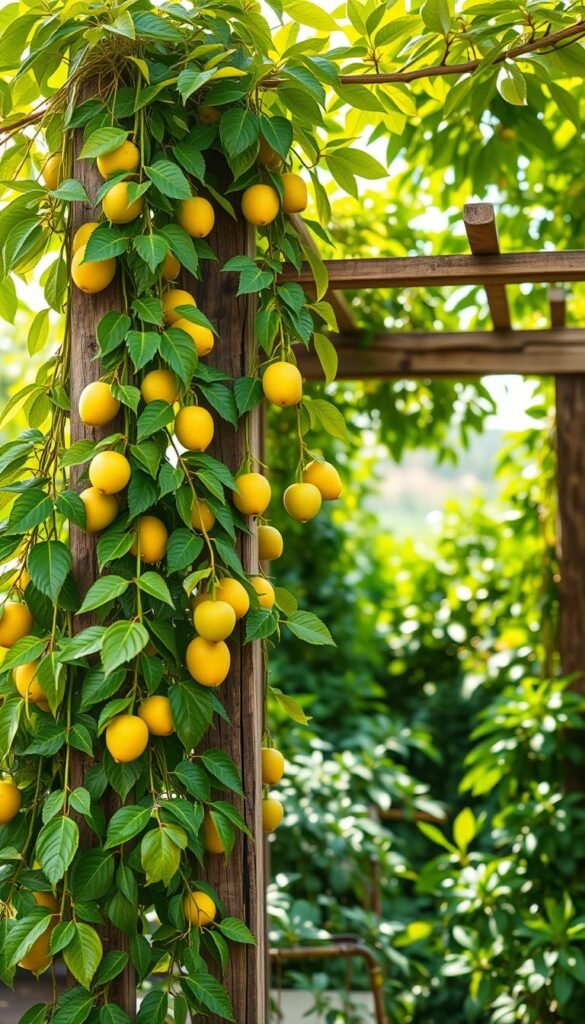
Elevate your outdoor experience with vertical systems that work smarter, not harder. These living walls turn plain surfaces into edible masterpieces, blending practicality with striking natural artistry. Flowers burst forth like fireworks, their intricate patterns drawing pollinators while you enjoy the show.
Maximizing Space While Enhancing Beauty
Smart vertical designs outperform ground-level growing in three key ways. They expose more leaves to sunlight, improve air movement between stems, and keep ripening treasures at eye level. This trifecta directly impacts fruit production while simplifying maintenance.
Compare traditional vs vertical setups:
| Feature | Horizontal Growing | Vertical System |
|---|---|---|
| Space Used | 15-20 sq ft | 4-6 sq ft |
| Harvest Access | Bending required | Waist-high picking |
| Disease Risk | High | Low |
Your garden gains unexpected perks beyond bigger harvests. Those fast-growing tendrils mask chain-link fences or outdated sheds within weeks. Neighbors will admire the living curtain of heart-shaped leaves and otherworldly blooms.
Proper training transforms functional supports into focal points. As vines mature, their twisting patterns create natural sculptures. You’ll enjoy seasonal changes – spring’s purple buds, summer’s juicy rewards, and autumn’s golden foliage.
Selecting the Right Trellis and Garden Supports
Choosing the perfect framework for vigorous growers requires equal parts engineering and artistry. Your structure must withstand nature’s forces while blending seamlessly into your outdoor space.
Factors to Consider for Stability and Aesthetics
Start by assessing weight capacity. Mature vines with fruits can pull down weak structures during storms. Use these guidelines:
| Material | Max Height | Lifespan |
|---|---|---|
| Pressure-treated wood | 8-10 ft | 5-7 years |
| Galvanized steel | 12-15 ft | 15+ years |
| Reinforced concrete | Unlimited | Permanent |
Balance durability with visual appeal. Rustic wooden lattices charm cottage-style yards, while sleek metal grids suit modern spaces. Ensure crossbars sit 12-18″ apart for optimal grip.
Incorporating Multiple Supports for Large Vines
Expandable systems adapt as plants mature. Combine vertical posts with horizontal wires or mesh panels. Modular trellises let you add sections yearly, matching your vine’s explosive growth.
Anchor supports 2′ deep in concrete for wind resistance. Space multiple frames 4-6′ apart along walls or fences. This creates air channels that reduce mildew risk while supporting heavy fruit clusters.
Planting and Training Your Passionfruit Vines
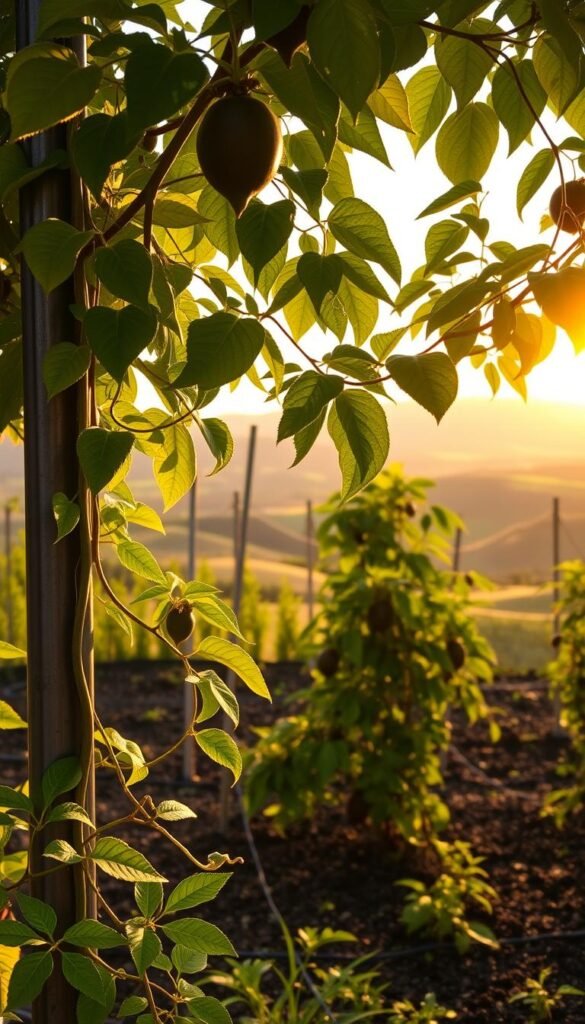
Nurturing vigorous climbers begins with smart planting strategies. Timing matters most when moving young starters to their permanent home. Watch for that magic 8-inch height mark – it signals readiness for transplanting without overwhelming the root system.
Step-by-Step Planting Techniques
Dig a hole twice as wide as the root ball to give roots breathing room. Mix native soil with equal parts compost – think chocolate cake crumbles, not dense mud. If your seedling outgrew its pot, trim the top growth by one-third to balance moisture needs.
| Planting Stage | Key Action | Benefit |
|---|---|---|
| Hole Preparation | 2x root ball width | Prevents root circling |
| Soil Mix | 50% native soil + 50% compost | Boosts nutrient access |
| Post-Planting Care | 3-inch mulch layer | Regulates soil temperature |
Tying and Training Methods to Encourage Climbing
Young vines need gentle guidance. Use stretchy fabric strips instead of rigid ties – they accommodate growth spurts without cutting stems. Position supports every 12 inches to create a ladder effect for tendrils.
| Training Material | Advantage | Duration |
|---|---|---|
| Soft fabric strips | Flexible support | 6-8 months |
| Biodegradable twine | Natural decomposition | 1 season |
| Velcro plant tape | Reusable fastening | Multiple years |
Angle stems at 45 degrees toward your structure – this mimics their natural climbing posture. Check ties weekly, loosening as bark thickens. Within weeks, those clever tendrils will grip supports independently.
Watering, Feeding, and General Care for Lush Growth
Keeping your vigorous climbers thriving requires smart hydration and nutrition strategies. These heavy producers work overtime, demanding precise care to maintain their showstopping performance.
Tips for Consistent Watering and Mulching
Water deeply 2-3 times weekly during dry spells, targeting the root zone. Morning irrigation lets leaves dry before nightfall. Spread 4 inches of straw mulch around the base to lock in moisture without suffocating roots.
Test soil drainage by digging a 12-inch hole. If water remains after an hour, mix in gravel or sand. Container growers should use pots with multiple drainage holes and saucers to prevent sogginess.
Selecting the Right Fertilizer and Nutrient Balance
Choose a 5-7-6 formula during flowering stages. Apply every 6 weeks, scratching granules into the topsoil. For homemade solutions, blend compost tea with crushed eggshells for calcium boosts.
Avoid high-nitrogen mixes that prioritize leaves over fruits. Yellowing foliage signals magnesium deficiency – sprinkle Epsom salts around the drip line. Always water thoroughly after feeding to prevent root burn.
With proper care, your vine becomes a perennial powerhouse. Monitor moisture levels daily during heatwaves, and adjust feedings as the plant matures. Consistent attention yields sweet rewards season after season.

